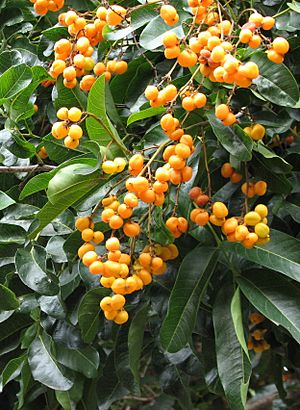Blunt-leaved tulip facts for kids
Quick facts for kids Blunt-leaved tulip |
|
|---|---|
 |
|
| Leaves and fruits, City Botanic Gardens Brisbane | |
| Scientific classification | |
| Genus: |
Harpullia
|
| Species: |
hillii
|
 |
|
| Occurrence data from AVH | |
The Harpullia hillii, often called the blunt-leaved tulip or oblong-leaved tulip, is a beautiful tree. It belongs to the Sapindaceae family, which includes plants like maple and lychee. This tree is found only in eastern Australia.
Most Harpullia hillii trees grow to be less than 10 metres (about 33 feet) tall. Some can reach up to 20 metres (about 66 feet). Its leaves are made up of 4 to 12 smaller leaflets. These leaflets are shaped like long ovals. They are usually 5 to 15 centimetres (2 to 6 inches) long and 2 to 6 centimetres (1 to 2.5 inches) wide.
Contents
What Does It Look Like?
Flowers and Fruit
This tree has pretty white flowers. Each flower petal is about 10–12 millimetres (less than half an inch) long. The flowers grow in clusters called panicles, which can be 10–25 centimetres (4 to 10 inches) long.
After the flowers, bright orange fruits appear. These fruits are round, about 25–30 millimetres (1 to 1.2 inches) across. They are also about 12–14 millimetres (0.5 inches) long. As the fruit gets older, it becomes woody. Inside, you'll find shiny black seeds. These seeds stick out from a bright red part called an aril.
Where Does It Grow?
Natural Habitat
The Harpullia hillii tree grows in dry rainforest areas. You can find it from the Burdekin River in Queensland, all the way south to Wauchope in New South Wales. It prefers places that are a bit shady and protected from frost.
How Was It Discovered?
Naming the Tree
The first official description of Harpullia hillii was made in 1859. This was done by Ferdinand von Mueller, a government botanist from Victoria. He studied plant samples collected by Walter Hill. Walter Hill was the first manager of the City Botanic Gardens in Brisbane.
Uses and Wildlife
Growing in Gardens
People often plant Harpullia hillii in gardens. It's liked for its thick leaves and its colourful, but not edible, berries. It grows best in a spot that gets some shade and is safe from cold weather. You can grow new trees from fresh seeds. Just soak the seeds in water first!
Home for Butterflies
This tree is also important for some insects. The caterpillars (larvae) of a butterfly called the Common Pencilled-blue butterfly (Candalides absimilis) love to eat the leaves of Harpullia hillii.
Art and Nature
In 1887, a famous botanical artist named Ellis Rowan painted Harpullia hillii. She included it in a beautiful watercolour painting along with another plant, Mackinlaya macrosciadea.

